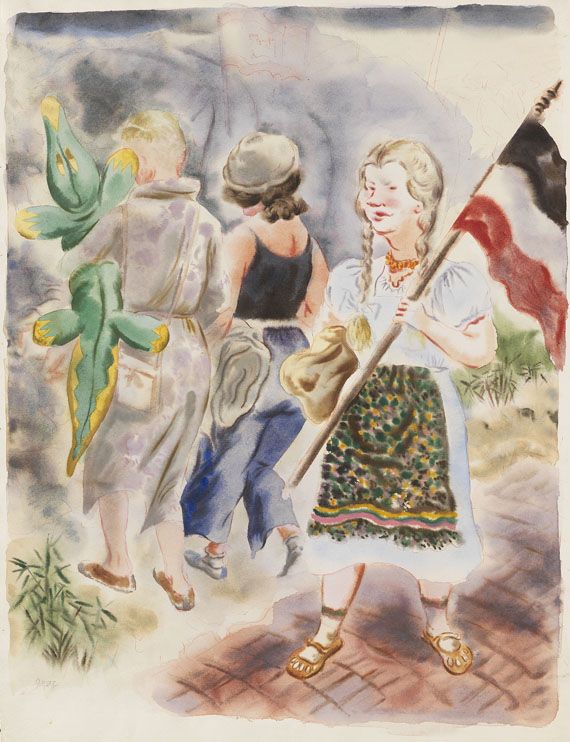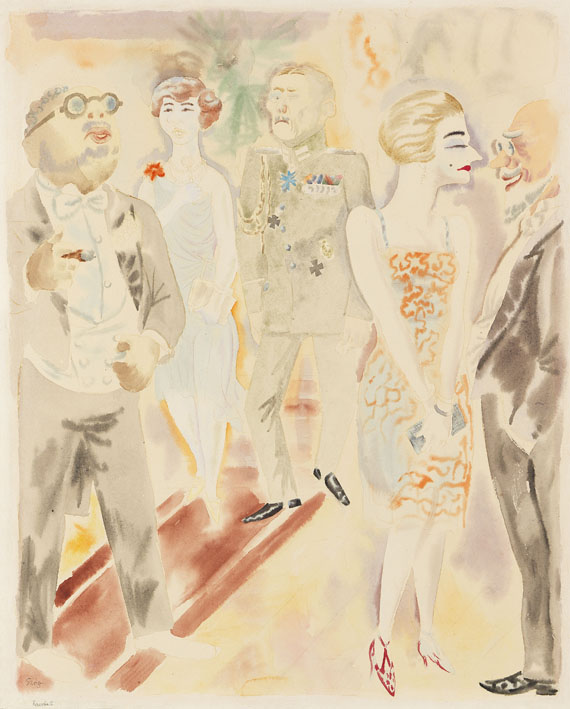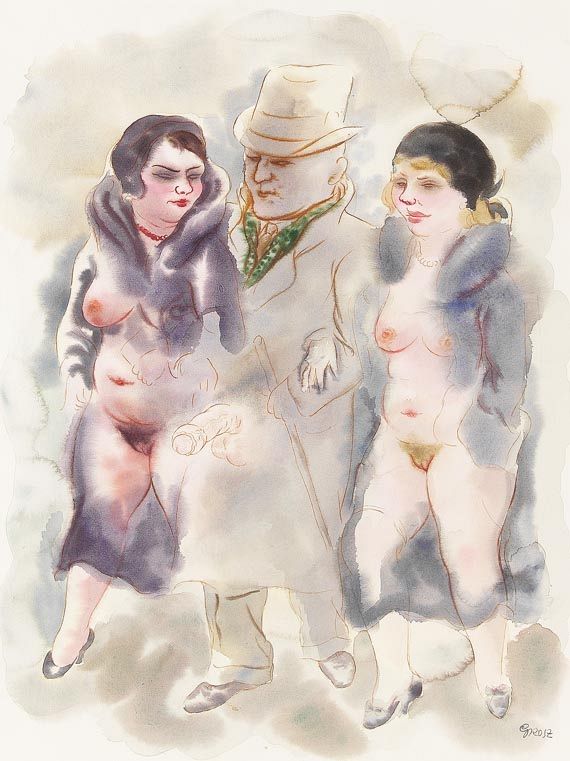BLINDER BETTLER MIT STOCK IN TROSTLOSER LANDSCHAFT Aquarell auf Karton. Sichtmaß: 58 x 44 cm. Rechts unten signiert. Auf der Rückseite des Blattes (freigehalten durch Fenster im Abdeckkarton) in Blei „L3 Nummer 793“ sowie in Tusche auf Gummistempel „1 84 10“, daneben in Blei „1939“. Im Passepartout, hinter Glas gerahmt.
Deutsch-amerikanischer Maler und Grafiker, ursprünglich der Neuen Sachlichkeit zugewandt. Grosz gilt als der bedeutendste Vertreter der gesellschaftskritischen Darstellung der Zeit zwischen den Weltkriegen, wobei der Erste Weltkrieg auf sein Werk besonders eingewirkt hat, dies kommt besonders auch in dem hier vorliegenden Gemälde zum Ausdruck. Nach links gewandt auf einem Stein sitzend, der angeschmutzte und geflickte Mantel zum feuchten Boden herabziehend, zudem mit Flicken genähte Schuhe unter ehemals elegantem Stresemannanzug. Rechts daneben ein Homburghut. In der Hand hält er einen Krückstock mit angebundenem Beutel. Von extremer Ausdruckskraft der steif nach links gerichtete Kopf mit dem starren Blick eines Blinden. Für die Tragik der Lichtlosigkeit hat Grosz links oben die von Wolken diesig verhangene Sonne wiedergegeben, darunter auffliegende Vögel. Die heruntergekommene Kleidung zeigt den ehemaligen Wohlstand des Dargestellten, dessen Schicksal sich in der Tragik des Ersten Weltkrieges gewandelt hat. Die verso in Blei angebrachte Jahreszahl „1939“, als Beginn des Zweiten Weltkrieges, gibt dem Werk eine zusätzliche visionäre Konnotation. (1100321) (11) George Grosz born Georg Ehrenfried Groß, 1893 Berlin – 1959 ibid. BLIND BEGGAR WITH STICK IN BLEAK LANDSCAPE Watercolour on card. Visible size: 58 x 44 cm. Signed lower right. On the reverse of the card (visible through a window in the backing board) pencil inscription “L3 Nummer 793” and watercolour inscription no. “1 84 10” over rubber stamp and no. “1939” in pencil beside it. Framed with mount behind glass. German-American painter and graphic designer originally devoted to The New Objectivity movement. Grosz is regarded as the most important advocate of socio-critical depictions between the two World Wars. The First World War in particular influenced his work as can be seen in the offered painting. The beggar is sitting on a stone and turned towards the left, his dirty and patched coat hanging down on the wet floor. He is wearing patched shoes and a formerly elegant stroller suit beneath his coat. A homburg hat is placed to the right and the beggar is holding a walking stick with a sack tied to it. The painting is characterised by an intense expressiveness with the beggar’s head rigidly turned to the left and the fixed gaze of a blind man. Grosz conveys the sense of tragedy and darkness by painting a hazy, overcast sun in the upper left with birds flying up beneath it. The beggar's shabby clothes reveal the former wealth of the man depicted, whose fortunes have been turned upside-down by the tragedy of the First World War.
BLINDER BETTLER MIT STOCK IN TROSTLOSER LANDSCHAFT Aquarell auf Karton. Sichtmaß: 58 x 44 cm. Rechts unten signiert. Auf der Rückseite des Blattes (freigehalten durch Fenster im Abdeckkarton) in Blei „L3 Nummer 793“ sowie in Tusche auf Gummistempel „1 84 10“, daneben in Blei „1939“. Im Passepartout, hinter Glas gerahmt.
Deutsch-amerikanischer Maler und Grafiker, ursprünglich der Neuen Sachlichkeit zugewandt. Grosz gilt als der bedeutendste Vertreter der gesellschaftskritischen Darstellung der Zeit zwischen den Weltkriegen, wobei der Erste Weltkrieg auf sein Werk besonders eingewirkt hat, dies kommt besonders auch in dem hier vorliegenden Gemälde zum Ausdruck. Nach links gewandt auf einem Stein sitzend, der angeschmutzte und geflickte Mantel zum feuchten Boden herabziehend, zudem mit Flicken genähte Schuhe unter ehemals elegantem Stresemannanzug. Rechts daneben ein Homburghut. In der Hand hält er einen Krückstock mit angebundenem Beutel. Von extremer Ausdruckskraft der steif nach links gerichtete Kopf mit dem starren Blick eines Blinden. Für die Tragik der Lichtlosigkeit hat Grosz links oben die von Wolken diesig verhangene Sonne wiedergegeben, darunter auffliegende Vögel. Die heruntergekommene Kleidung zeigt den ehemaligen Wohlstand des Dargestellten, dessen Schicksal sich in der Tragik des Ersten Weltkrieges gewandelt hat. Die verso in Blei angebrachte Jahreszahl „1939“, als Beginn des Zweiten Weltkrieges, gibt dem Werk eine zusätzliche visionäre Konnotation. (1100321) (11) George Grosz born Georg Ehrenfried Groß, 1893 Berlin – 1959 ibid. BLIND BEGGAR WITH STICK IN BLEAK LANDSCAPE Watercolour on card. Visible size: 58 x 44 cm. Signed lower right. On the reverse of the card (visible through a window in the backing board) pencil inscription “L3 Nummer 793” and watercolour inscription no. “1 84 10” over rubber stamp and no. “1939” in pencil beside it. Framed with mount behind glass. German-American painter and graphic designer originally devoted to The New Objectivity movement. Grosz is regarded as the most important advocate of socio-critical depictions between the two World Wars. The First World War in particular influenced his work as can be seen in the offered painting. The beggar is sitting on a stone and turned towards the left, his dirty and patched coat hanging down on the wet floor. He is wearing patched shoes and a formerly elegant stroller suit beneath his coat. A homburg hat is placed to the right and the beggar is holding a walking stick with a sack tied to it. The painting is characterised by an intense expressiveness with the beggar’s head rigidly turned to the left and the fixed gaze of a blind man. Grosz conveys the sense of tragedy and darkness by painting a hazy, overcast sun in the upper left with birds flying up beneath it. The beggar's shabby clothes reveal the former wealth of the man depicted, whose fortunes have been turned upside-down by the tragedy of the First World War.















Try LotSearch and its premium features for 7 days - without any costs!
Be notified automatically about new items in upcoming auctions.
Create an alert